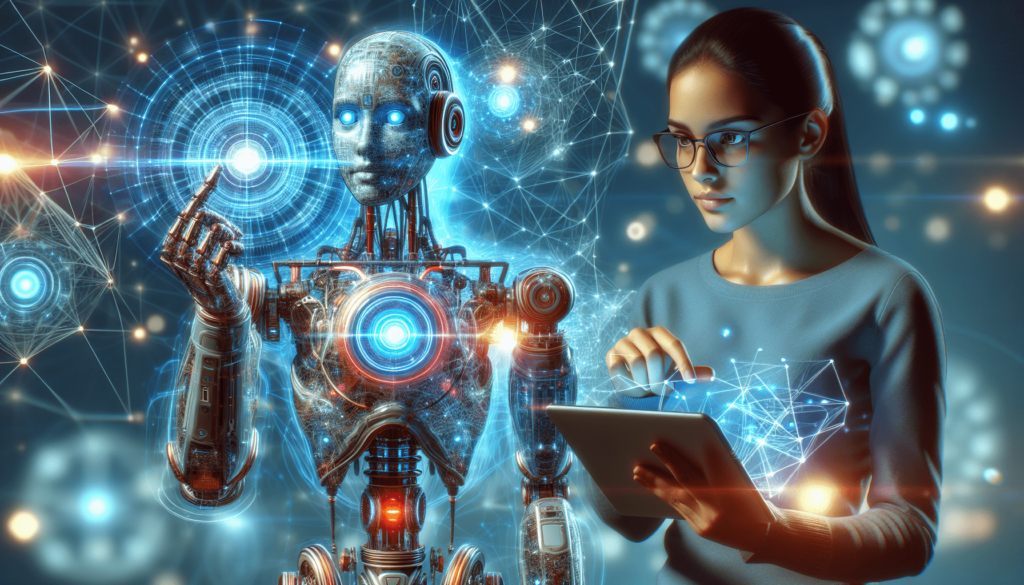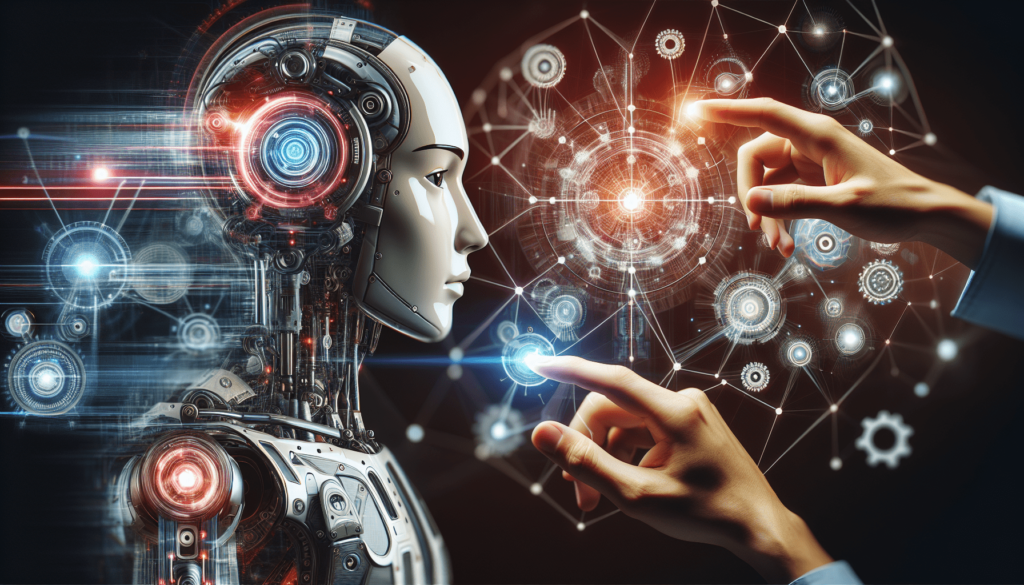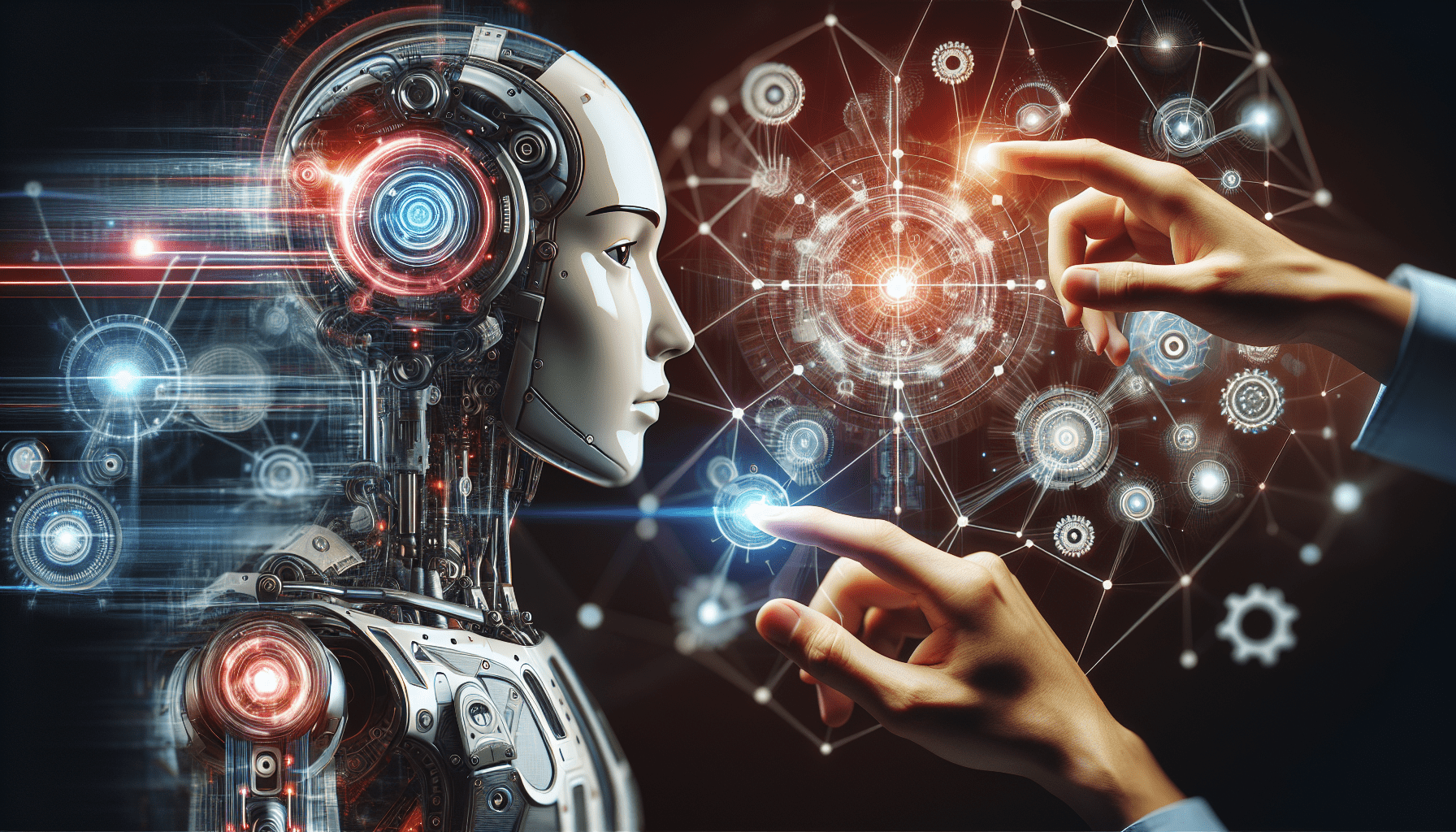Have you ever wondered which AI systems are in use today? From virtual assistants like Siri and Alexa to recommendation algorithms on streaming platforms, AI technology has become an integral part of our daily lives. In this article, we will explore some of the most commonly used AI systems across various industries, giving you a glimpse into the incredible innovations shaping our world. So, let’s embark on this exciting journey to discover the fascinating world of AI in use today!

Virtual Personal Assistants
Apple Siri
Apple Siri is a virtual personal assistant developed by Apple Inc. It is integrated into Apple devices such as iPhones, iPads, and Mac computers, allowing users to interact with their devices using voice commands. Siri can perform various tasks, including sending messages, making phone calls, setting reminders, and providing information on weather, sports scores, and news updates. It uses natural language processing and machine learning algorithms to understand and respond to user queries.
Amazon Alexa
Amazon Alexa is a virtual personal assistant developed by Amazon. It is primarily housed in smart speakers such as the Amazon Echo and can be controlled through voice commands. Alexa can perform a wide range of tasks, from playing music and answering general knowledge questions to setting timers and controlling smart home devices. With its extensive skills and integrations with various third-party apps and services, Alexa has become a popular choice among users looking for a versatile and feature-rich virtual assistant.
Google Assistant
Google Assistant is a virtual personal assistant developed by Google. It is available on various platforms, including smartphones, smart speakers, and smart displays. Google Assistant is known for its integration with Google’s ecosystem of services, providing users with personalized information and recommendations based on their usage data. It can perform tasks such as answering questions, setting reminders, making reservations, and controlling compatible smart home devices. Google Assistant also utilizes natural language processing and machine learning to provide accurate and relevant responses.
Microsoft Cortana
Microsoft Cortana is a virtual personal assistant developed by Microsoft. Initially introduced on the Windows Phone platform, Cortana is now available on various Microsoft products, including Windows 10, Xbox, and Microsoft 365. Cortana can assist users with tasks such as sending emails, scheduling appointments, and providing weather updates. It also offers integration with other Microsoft services, allowing users to access their files, calendars, and to-do lists seamlessly. Cortana utilizes both voice and text input to process user commands and generate appropriate responses.
Chatbots
Customer Support Chatbots
Customer support chatbots are AI-powered programs designed to assist customers with their inquiries and resolve common issues. These chatbots are often integrated into company websites or messaging platforms to provide instant and automated responses to customer queries. By analyzing user inputs and leveraging pre-determined algorithms, customer support chatbots can provide solutions, offer product information, or escalate complex issues to human agents if needed. The use of customer support chatbots helps businesses improve response times, reduce customer wait times, and handle a large volume of queries effectively.
Messaging App Chatbots
Messaging app chatbots are AI-driven chat interfaces integrated into messaging applications such as Facebook Messenger, WhatsApp, and Slack. These chatbots offer various functionalities, ranging from providing information and recommendations to completing transactions and booking appointments. For example, a messaging app chatbot for a food delivery service can assist users in placing orders, checking delivery status, and resolving common customer issues. With messaging app chatbots, users can seamlessly interact with businesses or services directly within their preferred messaging platforms.
Virtual Assistant Chatbots
Virtual assistant chatbots are AI-powered programs that aim to replicate the functionality of virtual personal assistants like Siri, Alexa, Google Assistant, and Cortana. These chatbots can be accessed through messaging apps, websites, or dedicated applications, providing users with personalized assistance and performing tasks based on their preferences. Virtual assistant chatbots can help users with various activities such as managing schedules, finding information, and making recommendations. Through machine learning and natural language processing, they continually improve their ability to understand user needs and provide valuable assistance.
Email Filtering
Spam Filters
Spam filters are AI-based systems designed to detect and block unsolicited and unwanted emails, commonly known as spam. These filters analyze the content, sender information, and other attributes of incoming emails to determine their legitimacy. By using pattern recognition, spam filters can identify common spam characteristics and prevent them from reaching the recipient’s inbox. Advanced spam filters often employ machine learning algorithms to adapt and improve their accuracy by learning from previous spam patterns and user feedback.
Email Categorization
Email categorization AI systems are developed to automatically classify and organize incoming emails based on their content and context. These systems use natural language processing and machine learning techniques to analyze the text and metadata of emails and assign them to relevant categories or labels. For example, emails may be classified as “personal,” “work,” “social,” or “promotions.” By categorizing emails, AI-driven email filters help users prioritize their inbox and locate specific messages more efficiently. This feature saves time and streamlines email management for individuals and businesses alike.
Smart Home Automation
Smart Thermostats
Smart thermostats are AI-powered devices that allow users to control and regulate their home’s temperature remotely and automatically. These devices utilize machine learning algorithms to learn user preferences and adjust temperature settings accordingly. By analyzing data related to external weather conditions, occupant presence, and energy consumption patterns, smart thermostats can optimize heating and cooling schedules to conserve energy and maximize comfort. Additionally, some smart thermostats integrate with virtual personal assistants, allowing users to control them using voice commands.
Smart Security Systems
Smart security systems employ AI technology to enhance the safety and security of residential and commercial spaces. These systems typically consist of security cameras, motion sensors, and door/window sensors that can detect and record activity within the premises. AI algorithms are used to analyze the captured video data and identify potential threats or suspicious behavior. Smart security systems can send real-time alerts to homeowners or security companies, enabling prompt action to mitigate any security risks. Furthermore, these systems can learn to recognize family members or trusted individuals, minimizing false alarms.
Smart Appliances
Smart appliances, such as refrigerators, washing machines, and ovens, are integrated with AI capabilities to enhance functionality and convenience. By connecting to the internet and utilizing machine learning algorithms, these appliances can adapt to user behavior and preferences. For example, a smart refrigerator can monitor food inventory, suggest recipes based on available ingredients, and even place online grocery orders when supplies are running low. Smart appliances also allow users to remotely control and manage their operations, providing flexibility and efficiency in everyday tasks.

Recommendation Systems
Product Recommendation Systems
product recommendation systems are AI algorithms employed by e-commerce platforms to suggest products that are likely to be of interest to individual users. These systems analyze user behavior, purchase history, and product attributes to identify patterns and make personalized recommendations. By understanding a user’s preferences and similarities with other customers, product recommendation systems can improve the shopping experience, increase customer engagement, and boost conversion rates. These systems are commonly utilized by major online retailers, ensuring users are presented with relevant and appealing product options.
Movie/TV Show Recommendation Systems
Movie and TV show recommendation systems leverage AI technology to provide personalized recommendations to users based on their viewing history, rating patterns, and genre preferences. These systems analyze vast amounts of data, including user ratings, online reviews, and metadata about movies and TV shows. By employing machine learning algorithms, recommendation systems can generate accurate predictions and suggestions, helping users discover new content that aligns with their interests. Popular streaming platforms and online entertainment services utilize these recommendation systems to enhance user satisfaction and engagement.
Music Recommendation Systems
Music recommendation systems are AI-driven algorithms that help users discover new music based on their listening habits, preferences, and contextual factors. These systems analyze data from various sources, such as user-generated playlists, user interactions, and audio features of songs. By employing techniques such as collaborative filtering and content-based analysis, music recommendation systems can generate personalized playlists, suggest similar artists or albums, and create personalized radio stations. These systems are widely used by music streaming platforms to provide users with an enjoyable and tailored listening experience.
Image Recognition
Facial Recognition Technology
Facial recognition technology uses AI algorithms to identify and verify individuals based on their facial features. By analyzing facial landmarks, unique facial patterns, and comparing them to a database of known faces, these systems can accurately recognize individuals in real-time. Facial recognition technology has various applications, from unlocking smartphones and verifying identities at airports to enhancing security systems and assisting in law enforcement investigations. However, concerns about privacy and potential misuse of facial recognition technology have also surfaced, sparking debates around its regulation and ethical use.
Object Detection and Classification
Object detection and classification AI systems are designed to identify and categorize objects within images or videos. These systems analyze visual cues and utilize deep learning algorithms to detect objects, locate their precise positions, and classify them into different categories. Object detection and classification have numerous practical applications, such as autonomous vehicles identifying pedestrians and road signs, or surveillance systems recognizing specific objects or behaviors. By constantly improving accuracy and speed, these AI systems contribute to advancements in computer vision and enable various automated tasks.
Medical Image Analysis
Medical image analysis technologies employ AI algorithms to analyze medical images such as X-rays, MRIs, and CT scans. These systems can detect and locate abnormalities, assist in diagnosing diseases, and provide additional insights to healthcare professionals. By examining images for patterns and anomalies that may not be immediately apparent to human observers, medical image analysis AI systems can improve the efficiency and accuracy of medical diagnosis. Integration of AI into medical imaging helps healthcare providers make more informed decisions, leading to better patient outcomes and potentially reducing diagnostic errors.
Natural Language Processing
Language Translation
Language translation AI systems use natural language processing techniques to automatically translate text or speech from one language to another. These systems employ algorithms that analyze sentence structure, grammar, and vocabulary to generate accurate translations. Language translation AI systems have become essential tools in bridging language barriers, enabling communication on a global scale. They are commonly used in various applications, from online translation services and language learning platforms to multilingual customer support and international collaboration.
Sentiment Analysis
Sentiment analysis, also known as opinion mining, is a technique that utilizes natural language processing and machine learning to identify and analyze emotions, attitudes, and opinions expressed in text. By analyzing patterns and keywords, sentiment analysis AI systems can determine whether a given text expresses positive, negative, or neutral sentiment. This technology is valuable in social media monitoring, brand reputation management, and market research, as it enables businesses to gauge public sentiment and respond effectively to customer feedback.
Text Generation
Text generation AI systems are designed to automatically produce human-like text based on given input or prompts. These systems employ techniques such as neural networks and language models to generate coherent and contextually relevant text. Text generation AI has various applications, including chatbots, automated content creation, and natural-sounding voice assistants. However, it is crucial to ensure responsible use of text generation AI, as it raises concerns about the potential spread of misinformation and the ethical implications of creating indistinguishable fake content.
Fraud Detection
Credit Card Fraud Detection
Credit card fraud detection AI systems leverage machine learning algorithms to detect patterns and anomalies in credit card transactions that may indicate fraudulent activity. These systems analyze factors such as transaction amount, location, customer behavior, and historical data to identify potential fraudulent transactions. By promptly flagging suspicious activities, credit card fraud detection AI helps financial institutions and cardholders prevent financial losses and protect against unauthorized usage. Continuous improvement and adaptation to evolving fraud techniques are essential to stay ahead of fraudsters and ensure secure transactions.
Identity Theft Detection
Identity theft detection AI systems are designed to identify potential instances of identity theft or fraudulent use of personal information. These systems analyze user behavior, login patterns, and other parameters to detect unusual activities that may indicate identity theft. By employing machine learning and anomaly detection techniques, identity theft detection AI can detect unauthorized access attempts and raise alerts to safeguard user identities and confidential information. Continuous monitoring and proactive detection are crucial in mitigating the risks associated with identity theft and protecting individuals’ personal privacy.
Autonomous Vehicles
Self-Driving Cars
Self-driving cars, also known as autonomous vehicles, are equipped with AI systems that enable them to navigate and operate without human intervention. These vehicles utilize a combination of sensors, cameras, and AI algorithms to perceive their surroundings, make decisions, and control their movements. Self-driving cars analyze real-time data to detect road markings, traffic signs, and other vehicles, ensuring safe and efficient movement on roads. Their potential benefits include reduced accidents and congestion, increased transportation accessibility, and improved energy efficiency.
Autonomous Drones
Autonomous drones are unmanned aerial vehicles that operate without direct human control. These drones are equipped with AI systems that enable them to navigate, perform tasks, and make decisions autonomously. Autonomous drones use sensors, cameras, and AI algorithms to detect and avoid obstacles, identify targets or objects of interest, and execute predefined flight paths. They have various applications, ranging from aerial photography and videography to package delivery and search-and-rescue operations. The use of AI in autonomous drones allows for enhanced capabilities, increased safety, and improved efficiency in a wide range of industries.
Content Moderation
Social Media Content Moderation
Social media content moderation AI systems employ algorithms to automatically detect and filter inappropriate, offensive, or violating content on social media platforms. These systems analyze texts, images, and videos posted by users, flagging content that violates community guidelines or poses potential harm. By automating content moderation, social media platforms can efficiently review large volumes of user-generated content and maintain a safe online environment. However, the challenge lies in striking a balance between accurate content moderation and avoiding false positives or negatives that may impact user experience and free expression.
Image and Video Moderation
Image and video moderation AI systems are used to automatically analyze and filter visual content, ensuring it complies with guidelines and policies. These systems employ computer vision and machine learning techniques to detect various attributes, including explicit or inappropriate imagery, violence, hate speech, or copyrighted material. By swiftly detecting and removing harmful or unwanted content, image and video moderation AI help online platforms maintain a safe and compliant environment. However, the complex nature of visual content analysis necessitates continuous improvement to enhance accuracy and adapt to emerging content trends.
In conclusion, AI has become an integral part of various industries and applications. From virtual personal assistants to content moderation and autonomous vehicles, AI systems provide enhanced capabilities and automation, revolutionizing the way we interact, work, and live. As AI continues to advance, its potential for innovation and transformation across different sectors remains vast. However, it is essential to address ethical considerations and ensure responsible use of AI to maximize its benefits and minimize potential risks. With ongoing research and development, AI systems will undoubtedly evolve, offering even more valuable and intelligent solutions for future challenges.
